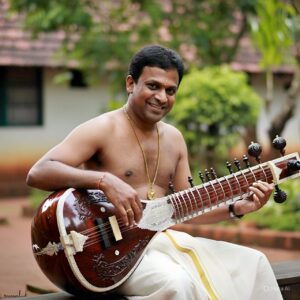
Kerala, a culturally vibrant state in South India, has long been a hub of traditional arts, music, and literature. Its musical heritage reflects deep historical roots and regional diversity, evolving from classical forms like Sopana Sangeetham and temple music to modern genres including film music and independent compositions. With changing times, Kerala’s music scene continues to embrace innovation while preserving its rich artistic legacy.
This blog explores how Kerala’s music has transformed through various stages, highlighting classical foundations, folk traditions, the modern film industry, and the rise of fusion and digital music—all while integrating more instruments and faster tempos to meet the preferences of today’s listeners.
Classical Roots: Kerala’s Musical Foundation
Kerala’s musical journey began with temple-based and classical music traditions. These were slow-paced, devotional, and focused on melody and spirituality.
1. Sopana Sangeetham and Carnatic Influences
Music performed in temples was typically solemn and soulful, using instruments like the idakka and chengila. The rhythms were minimal, and the focus was on vocal clarity and emotional expression. Over time, these forms integrated structured elements of Carnatic music, with the inclusion of instruments like the mridangam and violin.
Folk Music and Percussion: Rhythmic Cultural Expressions
Folk music in Kerala brought a new dimension with its community participation and dynamic rhythms. It relied heavily on percussion and was often performed during local festivals and rituals.
-
Chenda Melam and Panchavadyam introduced powerful beats, increasing in intensity over time.
-
Songs associated with folk dances and rituals like Kolkkali and Vanchipattu were performed in groups and had faster, rhythmic tempos, creating a festive atmosphere.
These traditions laid the groundwork for the use of multiple instruments and high-energy compositions in modern Kerala music.
Evolution Through Cinema: Blending Melody with Modernity
The introduction of the Malayalam film industry marked a significant shift in Kerala’s music. It transitioned from spiritual and folk-based sounds to a more orchestrated, cinematic experience.
1. Early Melodic Style
Initially, film songs were based on classical ragas and were rich in lyrical depth. They were performed with minimal instrumentation, mostly relying on the flute, tabla, and harmonium. The pace of these songs was moderate, focusing on emotional resonance.
2. Gradual Shift to Fast-Paced Songs
Over time, Malayalam film music began incorporating faster rhythms and diverse instruments such as drums, guitars, saxophones, and synthesizers. This evolution catered to changing audience preferences and a more fast-paced lifestyle.
Rise of Fusion, Fast Beats, and Instrumental Variety
With globalization and technological advancements, Kerala’s music began to embrace fusion and experimental genres. Contemporary songs now feature a blend of traditional and Western instruments.
1. Band Culture and Live Performances
The emergence of local music bands helped popularize alternative sounds that fused folk melodies with modern rock and electronic beats. These performances rely on electric guitars, keyboards, drum kits, and bass guitars, contributing to a rise in fast-paced songs that appeal to the younger audience.
2. Electronic and Digital Integration
Modern music producers frequently use digital tools, including loop stations, beat makers, and mixing software, to create upbeat, layered tracks. These are widely used in film background scores, dance numbers, and independent music videos.
Role of Independent Artists and Digital Platforms
The digital age has given rise to independent music creators who produce innovative and high-energy content outside traditional formats. Online platforms such as YouTube and music streaming apps have allowed these artists to reach global audiences, encouraging diverse musical experiments.
Fast songs created in home studios now include:
-
Looped percussion patterns
-
Heavy bass and techno beats
-
Layered vocal harmonies
-
Global instrument fusions like violin with EDM
Such trends are helping shape a new wave of Kerala’s music scene that thrives on accessibility and innovation.
Importance of Instruments in Kerala’s Modern Music
One of the key elements in Kerala’s contemporary music is the use of multiple instruments, creating a rich and dynamic audio experience. The focus has shifted from melody-based compositions to rhythm-heavy and beat-driven formats.
Key Instruments Used:
-
Drum kits and electronic pads for tempo and energy
-
Electric guitar and bass guitar for rhythm and groove
-
Synthesizers and keyboards for sound layering
-
Tabla, mridangam, and chenda for traditional fusion
-
Flute and violin for melodic interludes in fast compositions
This diversity of instruments contributes to highly engaging soundscapes, especially in fast songs that dominate digital platforms and live concerts.
Cultural Celebrations and Modern Music Integration
Kerala’s music festivals and cultural events are increasingly embracing contemporary styles.
Events now include:
-
Live performances with high-tempo fusion tracks
-
University competitions featuring electronic and rock genres
-
Local festivals where traditional instruments are paired with modern sound systems
These platforms promote new interpretations of musical tradition and help bring younger audiences into cultural participation.
Impact of Globalization on Kerala’s Music
Globalization has significantly impacted Kerala’s music by:
-
Encouraging cross-cultural collaborations
-
Introducing global instruments and music genres
-
Promoting the global distribution of Kerala-based music via digital platforms
Today’s music blends local flavor with international influences, creating a global yet distinctly Keralite sound.
Conclusion: Harmony of Heritage and Modern Rhythm
Kerala’s musical landscape reflects a beautiful transition—from the calm, devotional sounds of the past to the vibrant, fast-paced music of today. The extensive use of instruments and rhythmic innovation showcases how Kerala has embraced modern music trends without losing touch with its roots.
As technology, creativity, and cultural exchange continue to shape Kerala’s music, one can expect even more fusion, experimentation, and energy in the years ahead.
